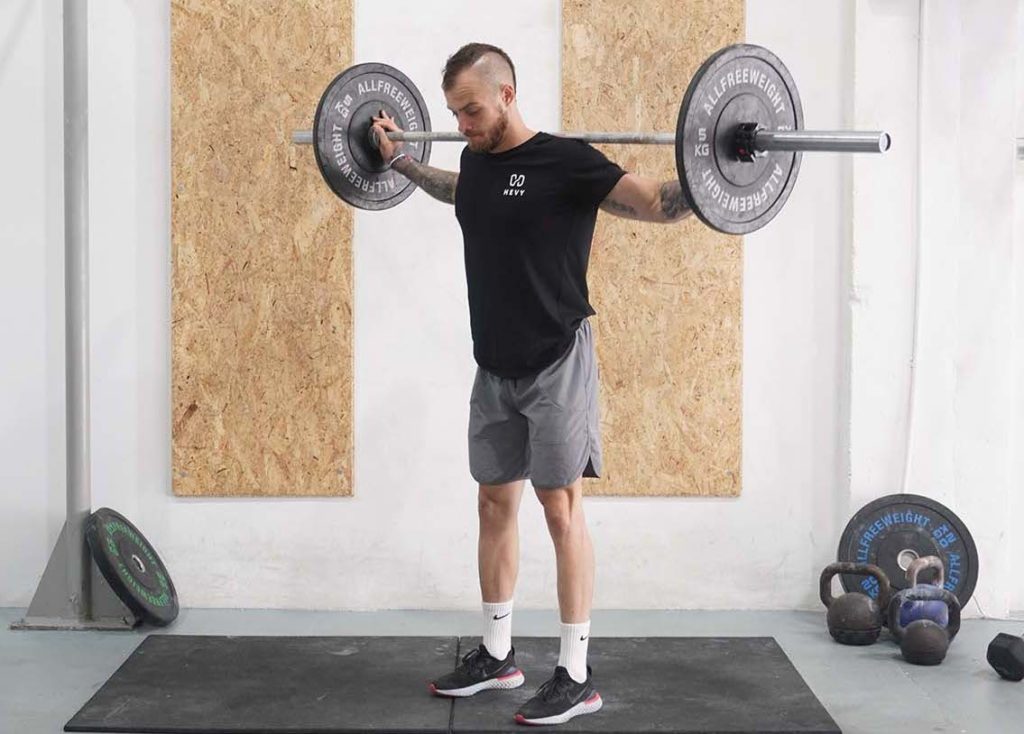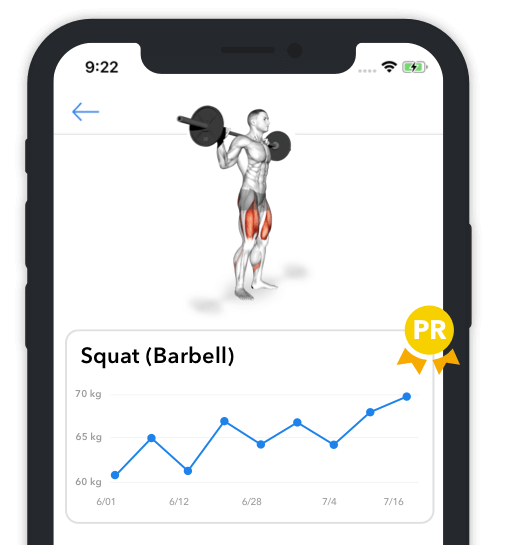Benefits of the Barbell Good Morning
Good mornings are one of the most effective barbell exercises you can use to strengthen your hamstrings, glutes, and back. The objective is to place a barbell on your back, similar to how you would set up for a low-bar back squat. But, instead of squatting, you maintain a slight bend in your knees and instead lean forward (hinge at the hips). Doing so stretches your posterior muscles. From there, you have to bring your torso back to the starting position by engaging the hamstrings, glutes, and back.
Unlike many posterior chain exercises, good mornings are great because of the incredible overload potential they offer. You can start with an empty barbell and gradually work up to 300, even 400 pounds.
Performing good mornings is a fantastic way to build whole-body balance, strengthen a range of large muscles, improve your athleticism, and become more functional. We recommend doing good mornings as a first or second exercise in your training.
How to do a Good Morning with a Barbell
- Set the bar up at around armpit height, and grip it evenly, slightly outside shoulder-width level.
- Tuck yourself under the bar and position it on your lower traps, around the level of your rear deltoids.
- Extend your upper back and press the bar against it with both hands. Keep your wrist straight and avoid having the bar rest on your hands.
- With your feet hip-width apart and firmly planted on the ground, push your hips forward, and unload the bar from its rack. Take a few steps back to clear enough space for the lift.
- With your back arched, bar firmly pressed against your back, and feet planted into the ground, take a breath and push your hips straight back.
- As you lower yourself, make sure to keep your back in a neutral position and instead think about pushing your butt back.
- Lower your torso as much as you can while keeping your back straight. You should feel an intense stretch in your posterior chain muscles. Near the bottom, you should allow for a slight bend in your knees.
- To get back up, initiate the movement by pushing your hips forward, thus ‘unfolding’ yourself.
What muscles does the good morning with a barbell activate?
The two primary muscle groups involved in good mornings are the glutes and hamstrings (1, 2). Both muscles produce hip extension (driving your hips forward as you stand up), which occurs during the second half of each repetition (3, 4). The hamstrings also provide stability at the knees and hips while performing repetitions (3). Your quadriceps produce some force to keep your knees at a consistent angle, but their role is primarily passive.
Your entire back is also involved in good mornings (1). The collection of muscles in the back provides torso stability and keeps your shoulders back as you lean forward and return to the starting position. Similarly, your midsection (abs, transverse abdominis, and obliques) flex isometrically to keep you stable. The chest, shoulders, and arms work to support the barbell on your back while performing good mornings.
Tips for the Barbell Good Morning
An important tip to keep in mind for good mornings is hinging at the hips correctly. The idea with the movement isn’t simply to bend forward but to do so while keeping your back in a safe, neutral position. Doing so will keep you stable, protect your spine, and allow you to load your hamstrings effectively.
So, before attempting to perform good mornings, start with simpler movements, such as learning how to hip hinge. One popular coaching option is to place a stick over the spine of a trainee and have them lean forward while keeping it in contact with the back. The activity is an excellent way to keep your spine neutral and teach you the proper movement pattern.

You can then transition to Romanian deadlifts, which feature a similar movement pattern before placing a barbell on your back for good mornings.
Once you start doing good mornings, keep the barbell in a steady position and perform each repetition slowly, ensuring that your posterior muscles engage. Strengthening your back, glutes, and hamstrings is also beneficial for solid good mornings. Exercises like Romanian deadlifts, barbell rows, glute-ham raises, and hip thrusts develop the posterior chain effectively (2, 5).
Variations and Modifications of the Good Morning with a Barbell
1. Slow Eccentric Good Morning
The slow eccentric good morning is a variation where you lean forward over three to five seconds, stretching your posterior muscles well. Once at the bottom, explode to the starting position by driving your hips forward with force.
2. Resistance Band Good Morning
Resistance band good mornings are useful for beginners and those with no barbell and squat rack access. The objective is to loop a long band over your neck and step over it. From there, assume a natural stance, brace your midsection, and lean forward as you normally would. Hold the bottom for a second and stand up, exhaling as you do.
3. Zercher Good Morning
Zercher good mornings are a version of the exercise where you place the barbell over the crease of your elbows and support it with your biceps. The primary benefits are that you strengthen your arms more and can drop the barbell on the floor if you fail to finish a repetition.
Mistakes to Avoid
One of the most common mistakes with good morning is allowing your back to round as you lean forward. As discussed above, good mornings take some time to master, so it’s best to learn the proper hip hinge pattern before doing the exercise. The goal is to bring your buttocks back as you lean forward, thus ensuring that your spine remains in a healthy neutral position.
The second common mistake with good mornings is placing too much weight on your back. Aside from boosting your ego, doing so offers no real benefits and prevents you from training through a full range of motion and stretching your posterior muscles well. Always pick loads that allow you to maintain good technique.
The third mistake with good mornings is keeping your knees locked out throughout the set. Doing so isn’t necessarily fatal, but it can make the movement unnecessarily tricky. Instead, you should maintain a slight bend in your knees and keep them at a consistent angle from start to finish.
Similar Exercises to the Good Morning with a Barbell
Glute Ham Raise

Glute ham raises are an accessory exercise that strengthens your hamstrings, glutes, lower back, and midsection (2). The objective is to go on a glute ham machine, anchor your feet, and engage your core. Once in position, use your posterior muscles to repeatedly lower and raise your torso.
Single Leg Romanian Deadlift (Dumbbell)
Single leg Romanian deadlifts are a fantastic accessory exercise that develops your hamstrings, strengthens your core, and improves balance. Plus, training one side at a time helps detect and fix muscle imbalances. Like classic Romanian deadlifts, the goal is to hinge at the hips while keeping your knees almost locked out. The only difference is, you’re keeping one foot planted, and the other one lifts back as you hinge.



